AMD Kaveri APU Launch Details: Desktop, January 14th
by Ryan Smith on November 11, 2013 9:33 PM EST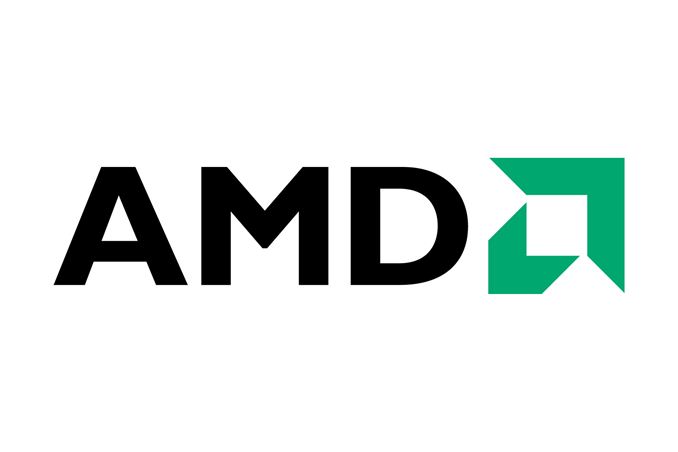
Kicking off today is AMD’s annual developer conference, which now goes by the name APU13. There will be several APU/CPU related announcements coming out of the show this week, but we’ll start with what’s likely to be the most interesting for our regular readers: the launch date for AMD’s Kaveri APU.
First and foremost, AMD has confirmed that Kaveri will be shipping in Q4’13, with a launch/availability date of January 14th, 2014. For those of you keeping track of your calendars, this is the week after CES 2014, with AMD promising further details on the Kaveri launch for CES.
Second of all, we have confirmation on what the highest shipping APU configuration will be. Kaveri will have up to 4 CPU core (2 modules), which will be based on AMD’s latest revision of their desktop CPU architecture, Steamroller. Meanwhile the GPU will be composed of 8 GCN 1.1 CUs, which would put the SP count at 512 SPs (this would be equivalent to today's desktop Radeon HD 7750). Furthermore AMD is throwing around a floating point performance number – 856 GFLOPS – which thanks to some details found in AMD's footnotes by PCWorld gives us specific clockspeeds and even a product name. A10-7850K CPU clockspeed 3.7GHz, GPU clockspeed 720MHz.
Third, in a departure from how AMD launched Trinity and Richland, Kaveri will be coming to the desktop first. The January 14th date is for the availability of desktop socket FM2+ Kaveri APUs, with server and mobile APUs to follow (these are presumably some of the CES details to come). Pricing and specific SKUs will of course be announced at a later time, and there wasn’t any clarification on whether this was just for OEM hardware, or if we’ll be seeing retail CPUs too.
Finally, AMD has confirmed on the GPU side that Kaveri will be shooting for feature parity with AMD’s latest discrete GPUs, by supporting many of the same features. Specifically, TrueAudio will be making an appearance on Kaveri, bringing AMD’s dedicated audio processing block to their APUs as well as their GPUs. On the discrete GPUs this is a move that was mostly about functionality, but on Kaveri it should take on a second role due to the fact that it’s exactly the kind of CPU-constrained environment for which having dedicated hardware will be a boon. Furthermore, AMD has also confirmed that their new low-level API, Mantle, will also be supported on Kaveri – it is after all a GCN based GPU.
For AMD Kaveri is going to be a big deal; likely the biggest CPU/APU launch for the company in quite some time. Since the acquisition of ATI all the way back in 2006 this is what the company has been building up to: producing a processor with a highly integrated CPU/GPU that allows both of them to be leveraged nearly-transparently by software. Kaveri is the launch vehicle for HSA both as a specific standard and as a general concept for a PC CPU/APU, so it’s something that everyone inside and outside of AMD will be watching closely.


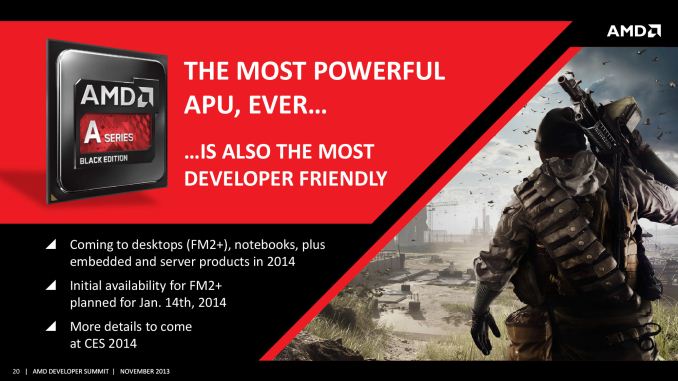
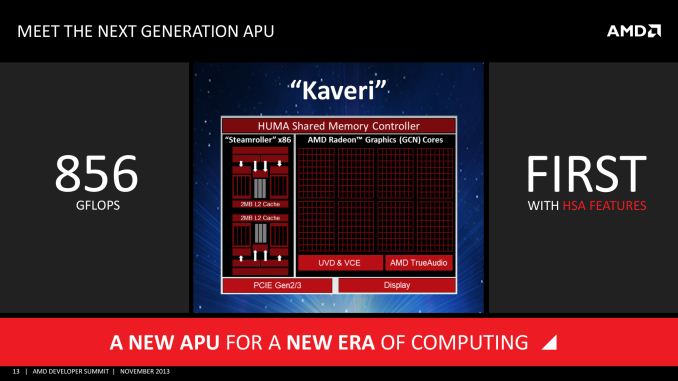
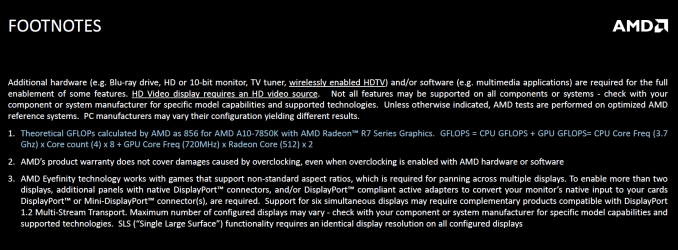

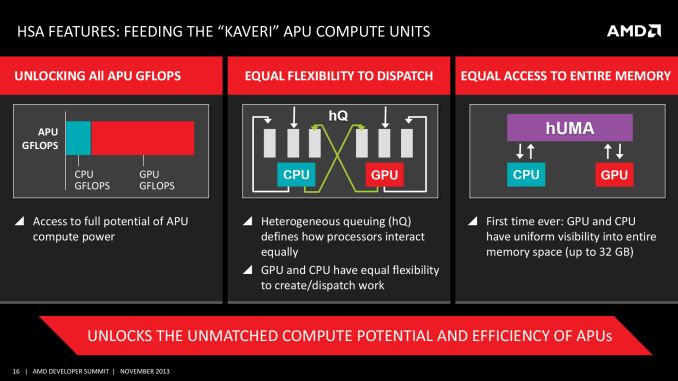








97 Comments
View All Comments
Penti - Tuesday, November 12, 2013 - link
Oh I wasn't really thinking about that they included the CPU in the GFLOPS. That makes A10-6800k 779 GFLOPS or the 8670D 648 GFLOPS and this new GPU just 737 GFLOPS. Though it's probably not the highest SKU, and the 3.7GHz is not the turbo freq.silverblue - Tuesday, November 12, 2013 - link
The worry appears to be that even at 856 GFLOPS, Kaveri is about 20% less powerful than previously touted. This article (with slides from AMD) shows Kaveri was originally meant to be at 1,050 GFLOPS, meaning a CPU clock speed reduction of 8%, but a dramatic GPU clock speed reduction of 25%. The assumption is based on the fact that the A10-7850K is the top Kaveri part, but that's a sound assumption.http://semiaccurate.com/2013/11/12/amd-misses-expe...
If this is true, it will barely outperform Trinity/Richland in synthetics, but we know those don't always matter. The real question now is - why is Kaveri less powerful than originally stated?
looncraz - Tuesday, November 12, 2013 - link
I think engineers over-estimated the performance increase with GCN 1.1 revisions or had to exclude an anticipated improvement to make their target dates... or power draw was more than expected...That could also explain why AMD was so unprepared with an updated cooler for the Hawaii GPUs...
Penti - Tuesday, November 12, 2013 - link
GCN 1.1 aka HD7790 has been out for a while and was retail before any pre-production ready engineerings samples of Kaveri.I think it's simply a matter of power and not the top sku possible. But that is symptomatic of AMD as that always happens way worse for the mainstream notebook chips. They cannot really keep doing that.
If you look at that AMD slide, Trinity is essentially where Richland ended up. So it's not GCN (1.1) specific really. A10-5800K was 736 GFLOPS. They said it would be 819 for the 2013 ed (Richland).
Wonder about the naming though, what comes after A10-7850K? XX90K?
jnad32 - Wednesday, November 13, 2013 - link
Mantle is kind of a big deal if only because it gets rid of the need for DirectX. Yes OGL has been there for years but clearly not many companies like it or at least don't want to use it for some reason. If this can catch on and AMD starts actually paying attention to their Linux drivers, They could become the goto company for Steam OS and gamers who don't like Windows in general.dylan522p - Wednesday, November 13, 2013 - link
Mantle is nothing at all like Direct X and could not possibly replace it as it doesn't have almost any features. Do you even understand what direct X is.ericore - Monday, November 11, 2013 - link
The most important thing for me is, is this new APU less of a bottleneck for FPS in games; does it compete with Intel; because Intel irrefutably leads at the moment. If it does, then it's a sensible purchase. Otherwise, it's a deal breaker. I'm much more excited about Nvidia's Kepler or whatever they are release in May, and why would I choose an AMD cpu if even its new its already lagging, having difficulty with CPU bound games.monstercameron - Monday, November 11, 2013 - link
can you not read? this is an apu, not a cpu this is where AMD leads. Worry about cpu perf when discrete cpus[if they are still a thing] launch and stop being silly.silverblue - Tuesday, November 12, 2013 - link
It's still a valid question, especially considering the touted improvements over the Piledriver architecture.AMD shouldn't really compare IGP coverage areas with Intel's chips. For one, AMD's cores are smaller, and despite the 2MB L2 per module, there's no L3 to factor into the equation. The i7, as an example, should have far more transistors devoted to its CPU portion than the 2M/4T Steamroller would.
jnad32 - Wednesday, November 13, 2013 - link
That doesn't seem fair to compair a $300 CPU to a $150ish APU.